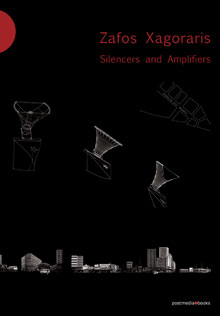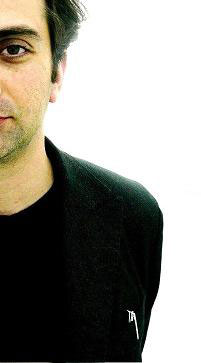
xagoraris
di Massimiliano Scuderi
Zafos Xagoraris’ work displays a recurrent idea with a related image, that of a beholder who observes other people, who watches a multitude from a distance, who compares the condition of the social being with an existential one of confinement. In some places, like Cyprus (2003-2005), all of that is very much present in the context itself: no people, nothing and nobody. But one may run into an amplifier, or a speaker, or some other item of rudimentary technology. The use of low-tech instruments plays a key role in the artist’s strategy, as their evident simplicity allows him to work in autonomy and be recognizable in urban installations. There is also a relationship between the lonely individual and the crowd these objects evoke with their presence. In Cyprus, for instance, the amplifiers reproduce sounds of everyday life, which in a particular environment assume an identity of their own, "as if they were people" (an expression used by Xagoraris himself during an interview in Pescara, August 2009) or, more precisely, isolated presences in deserted places.
Such elementary technology then represents a way to form a situation, an occasion, a space, or even just a line of communication for people.
The Inside and the Outside: the Determination of Limits
These categories, along with the element of distance, represent two of the crucial components in the artist’s line of research, and express the need for the continuous determination of a limit. That explains the frequent use, in urban environments, of devices such as bells, the sound of which determine ideal borders in all directions. Or the image of the archer drawing a circular fence with his arrows, thus establishing a possible borderline between the private and the public, determined by physical strength. The ongoing research for a line of separation between things constitutes a resource and a chance to create a new territory each time; a concept that introduces that of power, which is implied by the word itself (territory derives from terreo, a Latin verb meaning «to scare», thus detaining power), and the exercise of which determines the limits and the geography of various areas.
On Control
In Periscopes (Epikentro Gallery, Athens, 1998, 1st Biennale of Thessaloniki, 2007), Xagoraris addresses the possibility of control over other people and the territory, as in contemporary urban life, where public security is ensured through the use of cameras. This work is also about power and the relationship between the private and public dimension in the life of individuals and the community. The concept of control goes back to the speculation on territory and identity. Sometimes bells are walled in (as in China, in 798 district-Beijing), enclosed by four walls, thus creating parishes, coherent portions of territory, places, neighborhoods. The sound of bells is audible by everyone, and that defines a community and a network of parishes, a town as a system defined by identity.
Of norms and codes. How to Create an Exception in the Use of Public Spaces
In a 2008 installation in Brooklyn (Inner Fence, Art Lot), a one-meter corridor is obtained through fencing, separating a public area from a private one. Metallic fences were located on the perimeter of a lot, marking the invisible limit between the two areas. A fundamental element in this work is the bureaucratic process of permits, codes and laws governing the legal status of the corridor. The strategy is to make small changes in the outline and use of public urban spaces, but also, partially, to play with the rules through little alterations that determine a different use of the spaces and a series of temporary events. In Thessaloniki, for instance, a party is held on a terrace. That goes against the current ruling that the terrace be used exclusively for laundry. The temporary use of the space, a party event, meant everyone could have free access to the terrace.
Eliminating Distances
Another recurring theme is the elimination of the distance between different realities. Sounds coming from distant sources are merged together, as are the realities they represent, abolishing distance in a factual, mental and socio-cultural sense. This is evident in works produced in deserted spaces, in remote, limited and detached locations. Amplifiers define the identity of such places. As in Acre, Brazil, where the sounds of a portion of the Amazon rainforest are brought into the urban area by playing recordings made on site, as if transporting them meant bridging the distance between the two places. The same concept was proposed at Manifesta 7 in Rovereto, with a melting pot of sounds coming from forgotten, different and distant places.
Of Shutting Up
The work for the Biennale Fin del Mundo in Ushuaia, in the Tierra del Fuego (2007), is about silencing an object such as a bell by drowning it in water near the harbor, as in an apocalyptic representation. The artwork consists of every phase of the process, including transportation of the aluminum bell to Argentina.
Camouflage
Something in public space that uses the same materials as in reality then reveals itself as a work of art. That is Heaven-Live, for the Athens Biennale, exhibited on the shores of Faliro, regarding the impossibility of distinguishing objects, habits and attitudes of everyday live from the programmed strategy of artistic action.
Anti-Monumentalism, or on the Destiny of an Artwork
This concept is related to many works, and concerns the temporary dimension of many of them. There is actually some irony about that, as some objects – such as the bell 'drowned' at the Ushuaia harbor or the equipment used for the São Paulo Biennale (2006) – have never been removed; they are still in place, belonging to the locals, who are probably still using them in a new way.
The Work of Art as an Ongoing Project
In all of Xagoraris’ artwork, the key is the method of thinking, planning and determining its destiny. A process that takes place in layers made of tracts of graphite and markers on paper, growing, tracing a line of thought, switching order, direction and destiny as it proceeds. A route developing from the project, keeping the structure of an artwork always open to change, an apparent fragility that becomes sculpture as it takes form, step by step, slowly.
